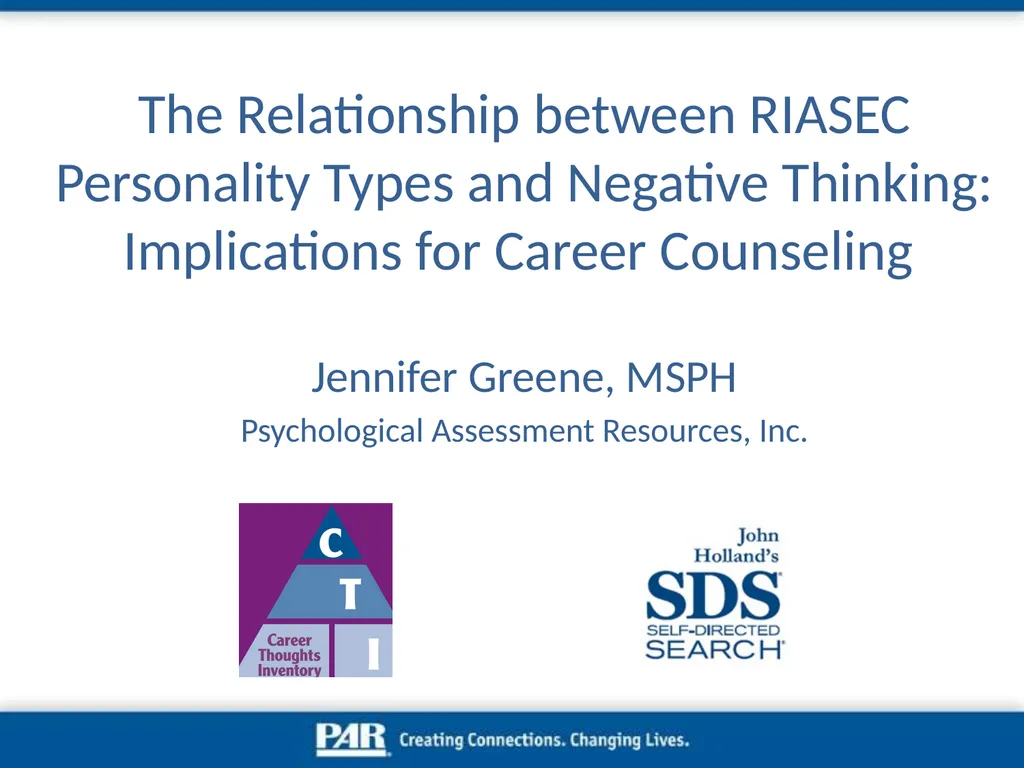The Relationship between RIASEC Personality Types
Author : danika-pritchard | Published Date : 2025-05-12
Description: The Relationship between RIASEC Personality Types and Negative Thinking Implications for Career Counseling Jennifer Greene MSPH Psychological Assessment Resources Inc My Background Masters of Science in Public Health Doctoral student
Presentation Embed Code
Download Presentation
Download
Presentation The PPT/PDF document
"The Relationship between RIASEC Personality Types" is the property of its rightful owner.
Permission is granted to download and print the materials on this website for personal, non-commercial use only,
and to display it on your personal computer provided you do not modify the materials and that you retain all
copyright notices contained in the materials. By downloading content from our website, you accept the terms of
this agreement.
Transcript:The Relationship between RIASEC Personality Types:
The Relationship between RIASEC Personality Types and Negative Thinking: Implications for Career Counseling Jennifer Greene, MSPH Psychological Assessment Resources, Inc. My Background Masters of Science in Public Health Doctoral student: PhD in Measurement at the University of South Florida Research and Development Team at Psychological Assessment Resources (PAR) Develop assessments for a wide variety of needs Career Development Also, achievement, intelligence, personality, mood, neuropsychology, speech/language, etc. Introductions Your background What made you want to come to this presentation? Agenda Research Objective Hypotheses Measures Used Method Participants Results/Discussion Case Study Objective To explore the relationship between RIASEC types (as measured by the Self-Directed Search) and negative career thoughts (as measured by the Career Thoughts Inventory) Hypotheses Hypothesis 1: Low scores on the SDS secondary constructs (congruence, consistency, coherence, differentiation, and profile elevation) are related to higher endorsement of negative career thoughts. Hypothesis 2: Social and Enterprising types are less likely to endorse negative career thinking, and R and C types are more likely to do so. Measures Self-Directed Search, Fifth Edition (SDS; Holland & Messer, 2013) Career Thoughts Inventory (CTI; Sampson, Peterson, Lenz, Reardon, & Saunders) Self-Directed Search (SDS) The SDS (Holland & Messer, 2013) is a self-administered career counseling tool. It is divided into four sections: activities, competencies, occupations, and self-estimates. The top three scores across all sections represent an individual’s Summary Code, the three personality types they most resemble. Hexagonal Model Secondary Constructs Related to Similarity Secondary Constructs Related to the RIASEC Profile Career Thoughts Inventory (CTI) The CTI is a theory-based assessment and intervention resource intended to improve the quality of career services offered. Cognitive information processing (CIP) theoretical approach to career development and career services (Peterson, et al., 1991; Peterson, et al., 1996) Cognitive therapy theoretical approach to mental health and mental health services (Beck, 1976). 10-15 minutes to complete Higher scores indicate higher levels of the scale’s measured construct. CTI Scales The CTI yields a CTI Total score (a single global indicator of dysfunctional thinking in career problem solving and decision making) as well as scores on three construct scales: Decision Making Confusion (14 items) This scale reflects an inability to initiate or sustain the decision making process as a result of disabling emotions and/or a lack of understanding about the decision making process itself. Commitment Anxiety (10 items) This scale reflects an inability to make a commitment to a specific career choice, accompanied by generalized














